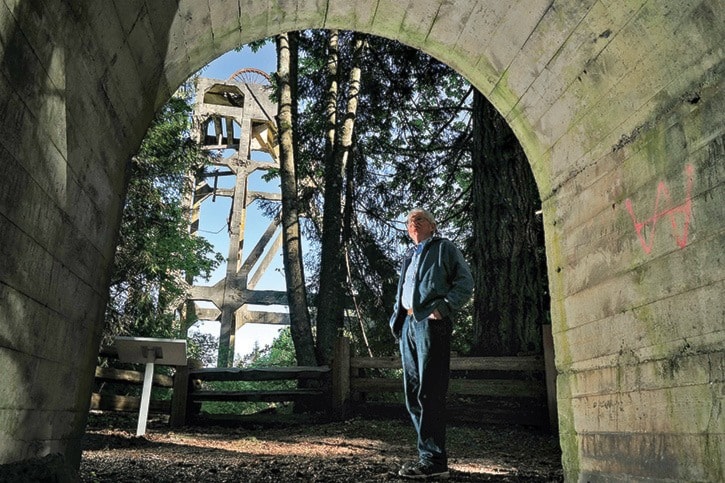A citizens’ group will surrender the fight to save Vancouver Island’s only remaining coal tipple after more than a decade of calling government to action.
Friends of Morden Mine is preparing to throw in the towel this fall after 12 years of working to honour one of only two remaining concrete coal tipples and head frames left in North America.
Society co-president Eric Ricker calls the decision a shame, but he also says the group has done all it can do.
The Friends of Morden Mine came together in 2003, and while there have been some changes at the park, its crown jewel – a seven-storey-high concrete tipple and head frame – has been left to deteriorate behind a chain-link fence.
More than a century ago it was used to lift and lower machinery and elevators into a 55-metre-deep mine shaft. The group’s vision has been to see it restored with a new interpretive centre on site to help tell the story of Vancouver Island’s coal mining past. But the dream has run into challenges, including financing to get the work done.
The role of the provincial park is to protect and preserve the remnants of coal mining history, but B.C. Parks isn’t able to pay for emergency repairs or restoration which it claims, at $2.7 million, would equate to 20 per cent of its entire capital program.
Other doors to dollars have closed because private funders aren’t interested in giving money to something under the province’s purview. The last straw for the society was when the Regional District of Nanaimo declined support for a federal grant application this year.
It’s at a dead end, says Ricker, who sees the tragedy in the end to the advocacy group. Without its work to publicize the mine and the need to get the structure fixed, he believes the tipple and head frame will sit there and rot.
There are places where the concrete has eroded and only the rebar is holding the structure and supporting columns. Sooner or later, something is going to give, he said.
“I think the publicity will stop once we stop and it’ll just sit there again as it did [before] 2003 with people not doing anything,” he said. “It’s very sad to see all of this tremendous effort come to an end, but at some point you just have to recognize that if the government is totally indifferent to its own park, there’s nothing more you can do and that’s the point that we’ve reached.” Judy Burgess, the society’s first president, said the news of the society disbanding is disappointing.
“They’ve worked very hard and I take my hat off to them and it’s too bad it had to end like this,” she said.
Ian Thorpe, a Nanaimo city councillor and regional district board member, says it would be a shame to see the mine head and tipple disappear, but it also comes down to finances and nobody wants to take responsibility for the huge cost if the province isn’t going to.
B.C. Parks enhanced visitor safety and viewing opportunities after recommendations of engineering and visitor safety risk assessment reports in 2013 and has an annual program of inspections and maintenance that includes Morden. But it’s not able to support an estimated $500,000 for emergency repairs to the mine structures or the estimated $2.2 million for restoration, a spokesman said in an e-mail, adding it hopes the Friends of Morden Mine or other community partners who have an interest in the repair and preservation of the structure can continue to support the project.
The society hopes, before it folds this fall, to put up a cairn at the park.
